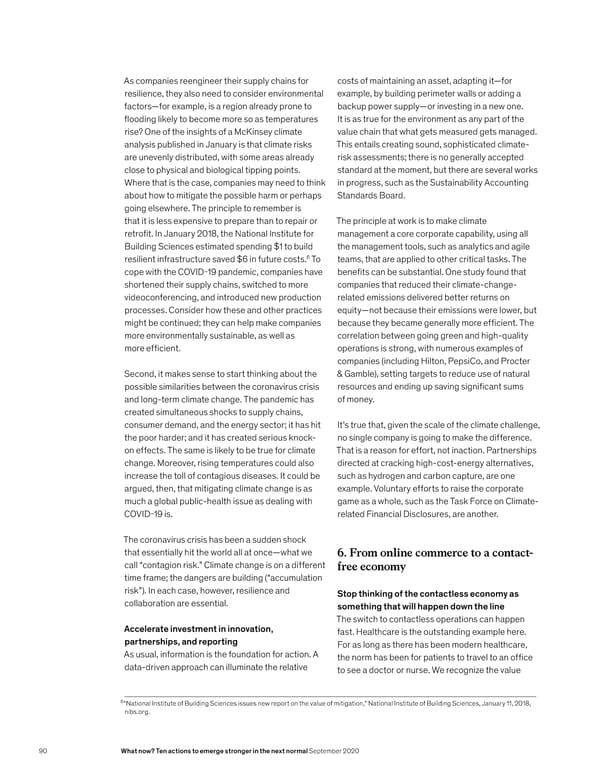As companies reengineer their supply chains for costs of maintaining an asset, adapting it—for resilience, they also need to consider environmental example, by building perimeter walls or adding a factors—for example, is a region already prone to backup power supply—or investing in a new one. flooding likely to become more so as temperatures It is as true for the environment as any part of the rise? One of the insights of a McKinsey climate value chain that what gets measured gets managed. analysis published in January is that climate risks This entails creating sound, sophisticated climate- are unevenly distributed, with some areas already risk assessments; there is no generally accepted close to physical and biological tipping points. standard at the moment, but there are several works Where that is the case, companies may need to think in progress, such as the Sustainability Accounting about how to mitigate the possible harm or perhaps Standards Board. going elsewhere. The principle to remember is that it is less expensive to prepare than to repair or The principle at work is to make climate retrofit. In January 2018, the National Institute for management a core corporate capability, using all Building Sciences estimated spending $1 to build the management tools, such as analytics and agile 6 resilient infrastructure saved $6 in future costs. To teams, that are applied to other critical tasks. The cope with the COVID-19 pandemic, companies have benefits can be substantial. One study found that shortened their supply chains, switched to more companies that reduced their climate-change- videoconferencing, and introduced new production related emissions delivered better returns on processes. Consider how these and other practices equity—not because their emissions were lower, but might be continued; they can help make companies because they became generally more efficient. The more environmentally sustainable, as well as correlation between going green and high-quality more efficient. operations is strong, with numerous examples of companies (including Hilton, PepsiCo, and Procter Second, it makes sense to start thinking about the & Gamble), setting targets to reduce use of natural possible similarities between the coronavirus crisis resources and ending up saving significant sums and long-term climate change. The pandemic has of money. created simultaneous shocks to supply chains, consumer demand, and the energy sector; it has hit It’s true that, given the scale of the climate challenge, the poor harder; and it has created serious knock- no single company is going to make the difference. on effects. The same is likely to be true for climate That is a reason for effort, not inaction. Partnerships change. Moreover, rising temperatures could also directed at cracking high-cost-energy alternatives, increase the toll of contagious diseases. It could be such as hydrogen and carbon capture, are one argued, then, that mitigating climate change is as example. Voluntary efforts to raise the corporate much a global public-health issue as dealing with game as a whole, such as the Task Force on Climate- COVID-19 is. related Financial Disclosures, are another. The coronavirus crisis has been a sudden shock that essentially hit the world all at once—what we 6. From online commerce to a contact- call “contagion risk.” Climate change is on a different free economy time frame; the dangers are building (“accumulation risk”). In each case, however, resilience and Stop thinking of the contactless economy as collaboration are essential. something that will happen down the line The switch to contactless operations can happen Accelerate investment in innovation, fast. Healthcare is the outstanding example here. partnerships, and reporting For as long as there has been modern healthcare, As usual, information is the foundation for action. A the norm has been for patients to travel to an office data-driven approach can illuminate the relative to see a doctor or nurse. We recognize the value 6 “National Institute of Building Sciences issues new report on the value of mitigation,” National Institute of Building Sciences, January 11, 2018, nibs.org. 90 What now? Ten actions to emerge stronger in the next normal September 2020
 What Now? Page 91 Page 93
What Now? Page 91 Page 93